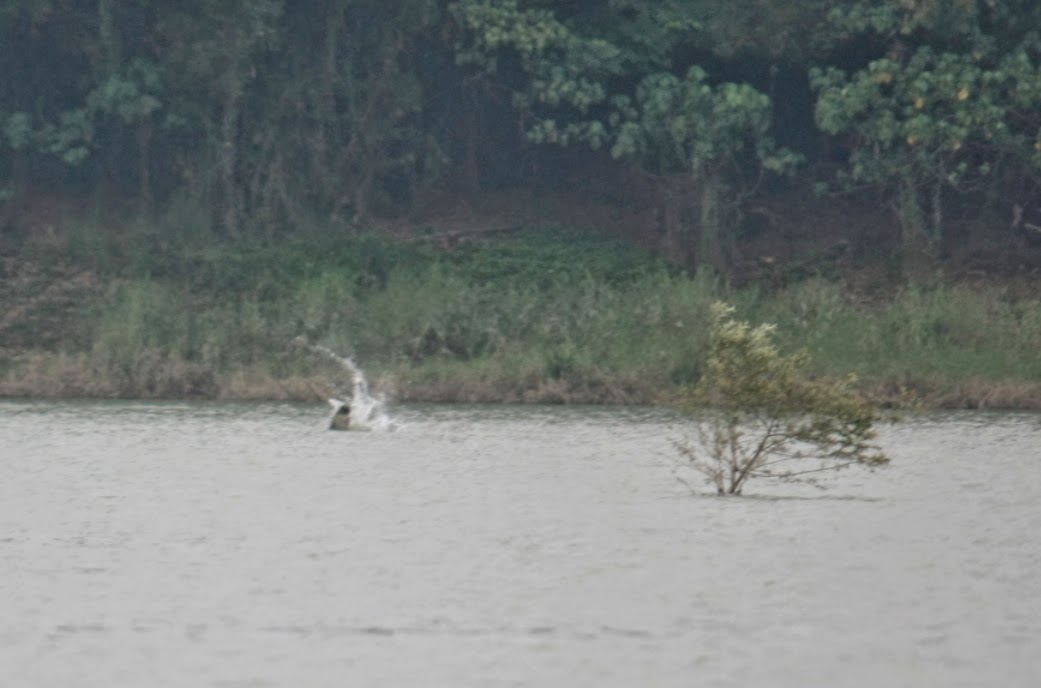Despite the recent rainfall, the shallow southern plain of the reservoir was still only a few feet deep; when the reservoir is full, the upper branches of these little bushes below would be a minor hindrance to my paddle - as they would be entirely submerged...
All of my necessary research is done here in southern Taiwan, so I really just came to hang out and watch the birds with no particular aim in mind. This egret flew particularly close to me early on...
As I was passing by the Guantian river as it enters the reservoir, guess who showed up...
I love the Ospreys; they are so difficult to photograph well because you are always at too much of a distance. It's shots like these that convince me I've come to the end of the line with my 250mm; for the type of shots I'm typically trying to take these days it just doesn't have enough reach.
This particular bird was all business and knew where the fish were. In the shallow area of Wushantou's southern plain, there are always fish leaping out of the water in and around the raft. Since I cannot be sure where and when they will next make an appearance, photographing them is even harder than photographing the Ospreys.
Typically the Ospreys will trail the surface of the water with their talons before ending up halfway submerged in the water themselves in a determined attempt to retrieve the fish...
This chap had two or three attempts, and it may be likely that, on average, Ospreys must make some considerable number of attempts before finally catching a fish...
Later this summer I plan to upgrade to a longer telephoto lens, so I should be able to make some substantial improvement on these kinds of shots. The major issue is cost, but even if money were no issue then the problem would be lens-length vs weight; a 300mm is not really any heavier than my current 250mm but it would probably have made a big difference today. Anything longer than 300mm is going to get be somewhat heavy and unwieldly; I'm not really sure what a 900mm or 1000mm lens is going to be like in practice.
At any rate, this shot wasn't too bad since the bird flew directly over my head...













Mike, thanks for putting up those pics of the osprey. I looked up osprey fishing success percentages, here, and found this:
ReplyDelete"Adult Ospreys were successful in 18.6% of their fishing attempts. The fishing technique of the Osprey is at least a partially learned behavior: adults required only 5.4 attempts per catch and 38.3 min per catch, but the young required 12.6 attempts and 77.3 min per catch."
That's from a Florida study, so I don't know if the osprey in your neck of the woods would have similar results or not.
Here's a osprey pic with the type of clarity you're probably shooting for.
I still think those rafts look old school, Mike, even if they are being manufactured on a regular basis.
John - that the fishing behaviour is partially learned is, I think, certain. To begin with, the birds would first need to identify those areas of water that are more likely to have fish, or, the right size of fish, and these areas may change over the seasons. On the act of catching itself, there would have to be a high degree of total body coordination beginning with the change in eye-focus from spotting the fish at a distance to reacting to their twists and turns in the water at close quarters. That this behaviour would need to be partially learned is even less surprising than the claim that flying itself must be partially learned as the chicks enter adolescence.
ReplyDeleteI have sometimes wondered whether there is something else they need to learn, and that is territorial behaviour in relation to the eagles. I have often seen both eagles and ospreys flying in the same general area, though with the ospreys typically at a lower altitude. I cannot recall ever seeing a kite, which is somewhat larger than an osprey, flying anywhere near the eagles (which are in turn, larger than the kites). The eagles do occasionally dive for fish (I once saw this at Tseng-wen reservoir - too late to take a picture), but I suspect that fishing behaviour by the eagles is rare enough for there to be little in the way of direct competition between the eagles and the ospreys. One advantage Ospreys have over the other two birds of prey is that since they feed exclusively on fish, there is no obvious way for them to be deliberately poisoned - a fate that often befalls the eagles back home in Britain who are in competition with landowners for game. I've heard of that happening in Taiwan, but I'm not sure how frequently it occurs.
On the raft - yes I agree, it is probably several decades old at least. The most recently constructed reservoir I have visited, Mudan reservoir in Pintung (completed nearly twenty years ago in 1995), had two such rafts next to a number of other more sophisticated boats, and I suspect that I will find more pipe-rafts when I eventually visit Baoshan 2 reservoir up north in Hsinchu County (completed in 2006). Their low construction and maintenance costs would make them ideal for jobs where there is no pressing requirement for high speed. Currently, there are also several new reservoirs being planned in both northern and southern Taiwan, with one of them nearing the end of construction now, so I might be able to find out about the manufacturer directly.